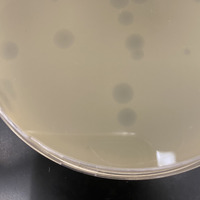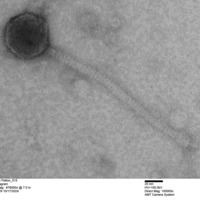Mycobacterium phage Bananagram
Know something about this phage that we don't? Modify its data.
| Detailed Information for Phage Bananagram | |
| Discovery Information | |
| Isolation Host | Mycobacterium smegmatis mc²155 |
| Found By | Landon Patton |
| Year Found | 2024 |
| Location Found | Bowling Green, KY United States of America |
| Finding Institution | Western Kentucky University |
| Program | Science Education Alliance-Phage Hunters Advancing Genomics and Evolutionary Science |
| From enriched soil sample? | Yes |
| Isolation Temperature | 30°C |
| GPS Coordinates | 36.9873 N, 86.45207 W Map |
| Discovery Notes | Soil Conditions - At the time of collection, the recorded temperature was 90 degrees Fahrenheit (around 32 degrees Celsius). The topsoil sample was relatively loose, with clumps ranging from less than 1 millimeter to 1 centimeter in size. While there were a few pieces of dead yellow grass, the sample was mostly uniform in consistency and content. Location - The sample was taken from the flowerbed surrounding the rotunda gazebo on top of the hill at Western Kentucky University. |
| Naming Notes | The name Bananagram serves as an analogy for gene expression. In the word game Bananagrams, players are dealt a hand of letters and must create words from them. When the letters are shuffled, they can form entirely different words with unique meanings. Similarly, when nucleic acids are rearranged, different genes are expressed, resulting in different processes being carried out in the cell. In the process of exploring my phage, I encountered a high concentration of clear plaque mutants, which arise from a mutated gene, similar to how rearranging letters can create new words. |
| Sequencing Information | |
| Sequencing Complete? | No |
| Genome length (bp) | Unknown |
| Character of genome ends | Unknown |
| Fasta file available? | No |
| Characterization | |
| Cluster | Unclustered |
| Subcluster | -- |
| Lysogeny Notes | My phage was able to produce a lysogen when a sample of infected cells had been inoculated and cultivated, then plated and treated with the phage lysate. The results of this treatment proved that my phage was able to produce a lysogen because the infected cells were immune to further infection from the same phage. |
| Annotating Institution | Unknown or unassigned |
| Annotation Status | Not sequenced |
| Plaque Notes | When incubated at 30 degrees Celsius for 24 hours, the phage produces a round, turbid plaque measuring approximately 0.5 centimeters in diameter without a bulls-eye pattern. |
| Morphotype | Siphoviridae |
| Has been Phamerated? | No |
| Publication Info | |
| Uploaded to GenBank? | No |
| GenBank Accession | None yet |
| Refseq Number | None yet |
| Archiving Info | |
| Archiving status | Not in Pitt Archives |
| SEA Lysate Titer | 1.45 * 10^9 |
| Available Files | |
| Plaque Picture | Download |
| Restriction Digest Picture | Download |
| EM Picture | Download |

